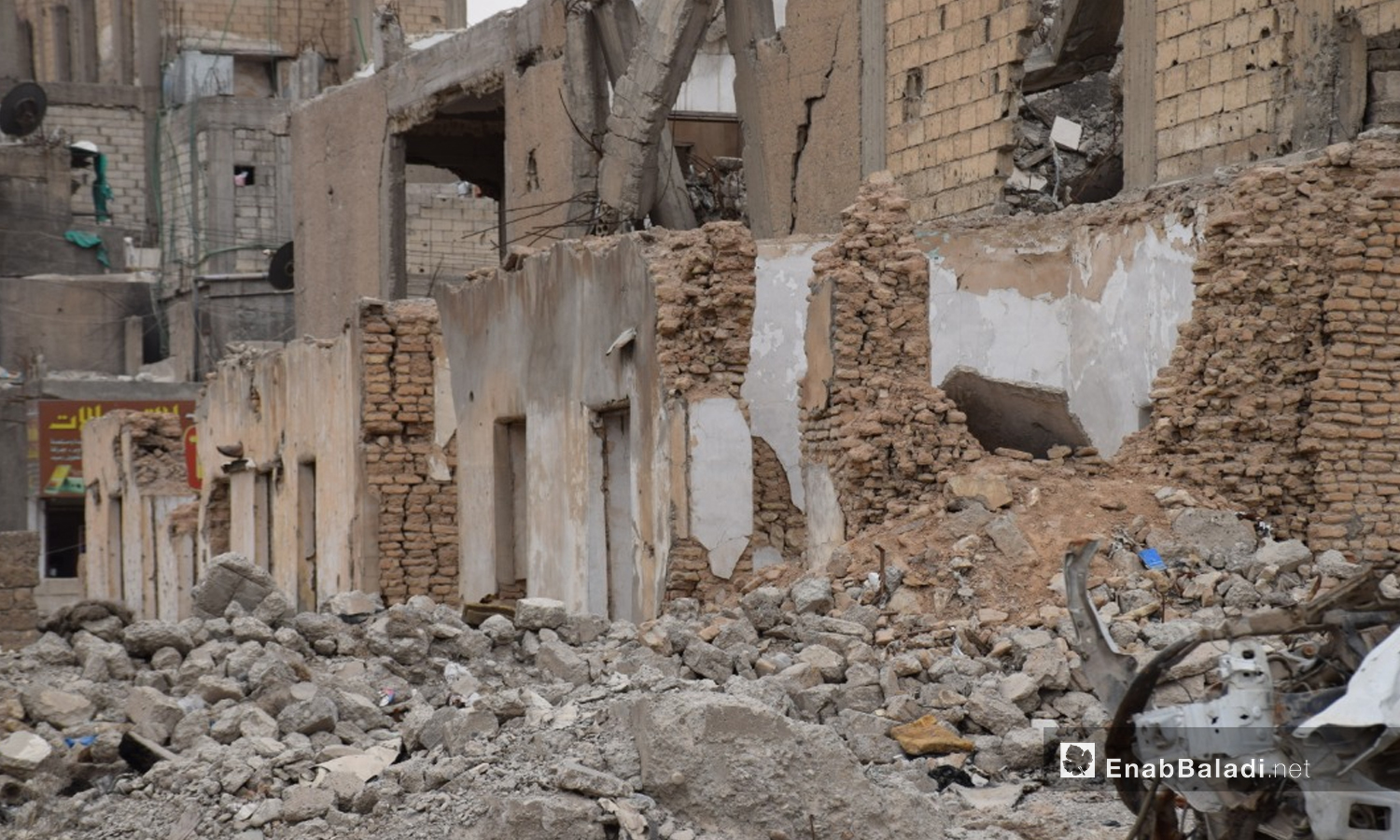



Al-Raqqa – Hussam al-Omar
Sitting in his wooden chair against the ruins of his family mud-brick house in the al-Mu’taz Street in al-Raqqa city center, Hamed al-Mhawesh recounted to Enab Baladi memories of his house, of which only a single bamboo chair was left.
The seventy-something-year-old man told Enab Baladi that his house was destroyed by the hostilities that took place in al-Raqqa city over the past years.
The heavy bombardment of the city almost completely destroyed the houses of the al-Raqqa’s old neighborhoods during the period of opposition control and then the Islamic State (IS).
The inability of the destroyed houses’ owners to restore them has led to their gradual disappearance from al-Raqqa after many homeowners or heirs decided to remove their properties’ rubble to establish floor buildings in their place.
Today, visitors wandering the streets of al-Raqqa and its neighborhoods surrounding the museum would be surprised to see remains of mud-stone houses scattered between modern concrete buildings spreading everywhere in the city.
“My son, if you only knew how much my brothers and I have played in this house. We used to wait for our father’s return from work right in this place,” with tears running down his cheeks al-Mhawesh said, pointing to the ruins of his destroyed house.
He added that his four sons had asked a construction contractor to remove the remains of the old house and build a multiple-story building, but he refused and requested to postpone the project’s implementation until after his death.
Mud-brick houses were built in downtown al-Raqqa city in the late Ottoman period at the building time of the municipality, the Ottoman Karakol (police station), and the eastern street market.
The modern city of al-Raqqa was reconstructed on the ruins dating back to the Abbasid Caliph Harun al-Rashid ruling period, having been almost completely destroyed during the Mongol invasion of the Levant.
The “new” al-Raqqa city contains several neighborhoods, namely al-Bakri, al-Hassoun, al-Blaybel, and al-Bayatra, formed at the beginning of the last century, the first nucleus for the transformation of the al-Raqqa population from an agricultural clan-based society to an urban civil society.
Thirty-five-year-old Ismail, one of Hamed al-Mhawesh’s sons, thinks that keeping the dilapidated house is pointless as long as the family cannot restore it.
Ismail said the Syrian war “wiped away memories and owners alike,” and he thinks it is useless today to cry over the past, but he and his brothers intend to respect their father’s wish in keeping the house ruins in place.
Al-Raqqa’s mud-stone houses were made with whatever available materials in the Jazira region, including earthen bricks, mud, reed, and wooden beams and canes, the al-Raqqa history researcher Mohsen al-Ali, who used to work in the field of archaeology told Enab Baladi.
Al-Ali added, these old houses are “at risk of disappearance” in al-Raqqa because of their owners’ lack of resources to restore them or their wish to replace them with modern buildings.
There are no accurate statistics for the number of old-styled clay houses or their space, but they are mostly distributed in the vicinity of the city’s repeatedly renovated museum and are owned by old families of al-Raqqa.
Enab Baladi contacted the Culture and Antiquities Committee of the al-Raqqa Civil Council to comment on the subject matter. A committee member who requested to remain anonymous because he is not formally authorized to address the media said that the committee can not prevent the removal of dilapidated mud houses for being private property, and their owners have the right to freely dispose of them.
The committee member pointed out that the committee had performed restoration works for some public buildings, “which stand for al-Raqqa’s cultural and historical heritage,” namely the al-Raqqa Museum, Qasr al-Banat (Palace of the Maidens), besides some sections of the al-Raqqa ancient wall.
Currently, the committee is working on restoring the Great Mosque, the oldest mosque in al-Raqqa, built over 100 years ago in tandem with the mud houses construction period.
The old city of al-Raqqa contains numerous Abbasid archaeological sites, which the United Nations Educational, Scientific and Cultural Organization (UNESCO) placed on the candidate list of World Heritage Sites in June 1999.
In November 2020, the RehabiMed association, the largest interdisciplinary network in the Mediterranean aimed at the sustainable rehabilitation, restoration of heritage, and urban regeneration, launched the project “Documentation and Protection of Cultural Heritage in al-Raqqa,” which proposed the formation of a team of local experts to assess the state of monuments, their damage extent, and priorities of needed consolidation interventions.
The project also pledged actions to involve the local population in the restoration process to know more about the importance of preserving the al-Raqqa’s heritage.
if you think the article contain wrong information or you have additional details Send Correction